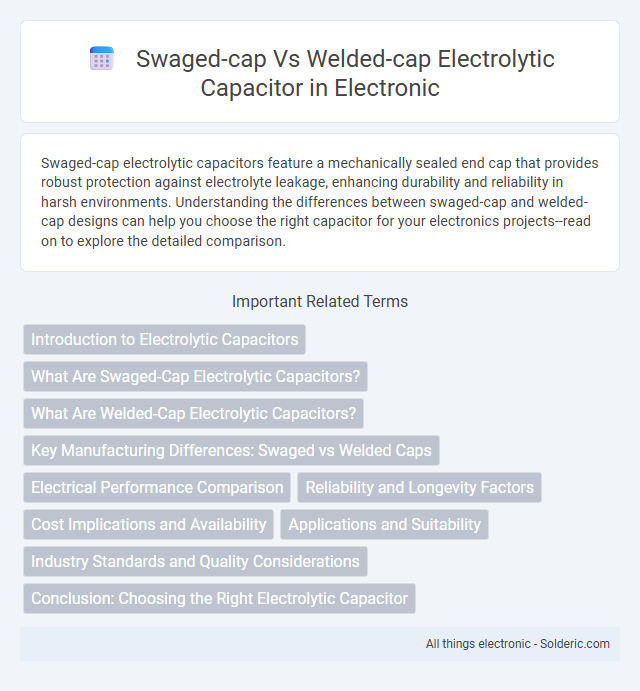Swaged-cap electrolytic capacitors feature a mechanically sealed end cap that provides robust protection against electrolyte leakage, enhancing durability and reliability in harsh environments. Understanding the differences between swaged-cap and welded-cap designs can help you choose the right capacitor for your electronics projects--read on to explore the detailed comparison.
Comparison Table
| Feature | Swaged-Cap Electrolytic Capacitor | Welded-Cap Electrolytic Capacitor |
|---|---|---|
| Sealing Method | Metal cap swaged mechanically onto the body | Metal cap welded to the can for hermetic seal |
| Leakage Resistance | Moderate; potential small leaks over long-term use | High; excellent hermetic sealing reduces leakage risk |
| Voltage Rating | Typically up to 450V | Up to 630V and higher |
| Operating Temperature | Standard ranges up to 85degC-105degC | Often supports higher temperatures up to 125degC |
| Mechanical Robustness | Good, but less resistant to vibration/shock | Superior vibration and shock resistance |
| Cost | Generally lower cost | Higher cost due to welding process |
| Typical Applications | Consumer electronics, general purpose | Industrial, automotive, high-reliability circuits |
Introduction to Electrolytic Capacitors
Electrolytic capacitors are polarized components widely used for filtering and energy storage in electronic circuits, characterized by their aluminum or tantalum anodes with an electrolyte-soaked paper or film serving as the dielectric. Swaged-cap electrolytic capacitors feature a mechanically sealed top, enhancing structural integrity and preventing electrolyte leakage, while welded-cap types utilize welded metal seals for superior hermetic sealing and higher reliability in demanding applications. Understanding the differences in cap construction helps you select the optimal electrolytic capacitor tailored to your circuit's performance and durability requirements.
What Are Swaged-Cap Electrolytic Capacitors?
Swaged-cap electrolytic capacitors feature a unique sealing method where the cap is mechanically pressed onto the capacitor's body, enhancing airtightness and reliability. This design reduces electrolyte leakage and improves performance under high temperatures compared to traditional welded-cap capacitors. Understanding these characteristics helps you choose the ideal capacitor for applications requiring long-term stability and durability.
What Are Welded-Cap Electrolytic Capacitors?
Welded-cap electrolytic capacitors feature a metal cap welded directly to the capacitor's aluminum case, ensuring a robust hermetic seal that prevents electrolyte leakage and enhances durability in harsh environments. This design offers improved electrical conductivity and reliability compared to swaged-cap capacitors, where the cap is mechanically pressed onto the case. Your choice of welded-cap capacitors is ideal for applications demanding high stability, long lifespan, and resistance to mechanical stress.
Key Manufacturing Differences: Swaged vs Welded Caps
Swaged-cap electrolytic capacitors feature a hermetic seal formed by mechanically pressing (swaging) the aluminum case onto the capacitor body, ensuring a compact design with effective moisture resistance. Welded-cap capacitors utilize a metal welding process to attach the end cap, providing superior hermeticity and enhanced reliability under high-temperature or high-vibration conditions. Your choice between swaged and welded caps depends on the specific application requirements for durability, environmental sealing, and manufacturing precision.
Electrical Performance Comparison
Swaged-cap electrolytic capacitors exhibit lower equivalent series resistance (ESR) and improved ripple current handling compared to welded-cap types, resulting in enhanced electrical performance in high-frequency applications. Welded-cap capacitors provide superior hermetic sealing, reducing leakage current and increasing reliability under harsh environmental conditions. Overall, swaged-cap models excel in transient response and thermal stability, while welded-cap designs prioritize longevity and stable capacitance over extended periods.
Reliability and Longevity Factors
Swaged-cap electrolytic capacitors exhibit higher reliability due to their hermetic sealing method, reducing electrolyte leakage and extending operational life under thermal stress. Welded-cap capacitors can be more susceptible to seal degradation over time, impacting longevity especially in high-temperature environments. Your choice should prioritize swaged-cap types for applications demanding enhanced durability and consistent performance.
Cost Implications and Availability
Swaged-cap electrolytic capacitors generally offer lower manufacturing costs due to simpler assembly processes, making them more cost-effective for high-volume applications. Welded-cap capacitors, though typically more expensive, provide enhanced mechanical stability and reliability, which can justify their higher price in critical or rugged environments. Availability of swaged-cap capacitors is broader, with widespread use across consumer electronics, while welded-cap capacitors are less common but preferred in specialized industrial or military-grade components.
Applications and Suitability
Swaged-cap electrolytic capacitors are preferred in applications requiring robust mechanical stability and resistance to vibration, such as automotive or industrial equipment, due to their secure cap attachment method. Welded-cap capacitors offer superior sealing and longer lifespan, making them more suitable for high-reliability electronics and medical devices where durability and leak prevention are critical. Your choice depends on the specific environmental stresses and longevity requirements of the application.
Industry Standards and Quality Considerations
Swaged-cap electrolytic capacitors typically conform to industry standards such as IEC 60384-4, offering robust sealing that enhances long-term reliability in harsh environments. Welded-cap capacitors, while meeting similar quality benchmarks, provide superior hermetic sealing that reduces electrolyte leakage and extends operational lifespan under high-temperature conditions. Your selection should be based on the specific application requirements, balancing standards compliance with desired durability and performance.
Conclusion: Choosing the Right Electrolytic Capacitor
Swaged-cap electrolytic capacitors offer superior mechanical stability and lower risk of electrolyte leakage, making them ideal for applications requiring robust durability. Welded-cap capacitors provide enhanced hermetic sealing and better performance under high-temperature conditions, suitable for high-reliability environments. Your choice should depend on the specific application requirements, balancing factors like mechanical stress, operating temperature, and long-term reliability.
swaged-cap vs welded-cap electrolytic capacitor Infographic

 solderic.com
solderic.com